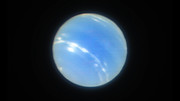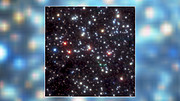Neptune from the VLT with and without adaptive optics
PR Image eso1824c
Neptune from the VLT and Hubble
PR Image eso1824d
MUSE images of the globular star cluster NGC 6388
Videos
ESOcast 172 Light: Supersharp Images from New VLT Adaptive Optics (4K UHD)
ESO’s Very Large Telescope (VLT) has
achieved first light with a new adaptive optics mode called laser
tomography — and has captured remarkably sharp test images of the planet
Neptune, star clusters and other objects. The pioneering MUSE
instrument in Narrow-Field Mode, working with the GALACSI adaptive
optics module, can now use this new technique to correct for turbulence
at different altitudes in the atmosphere. It is now possible to capture
images from the ground at visible wavelengths that are sharper than
those from the NASA/ESA Hubble Space Telescope. The combination of
exquisite image sharpness and the spectroscopic capabilities of MUSE
will enable astronomers to study the properties of astronomical objects
in much greater detail than was possible before.
The MUSE (Multi Unit Spectroscopic Explorer) instrument on ESO’s Very Large Telescope (VLT) works with an adaptive optics unit called GALACSI. This makes use of the Laser Guide Star Facility, 4LGSF, a subsystem of the Adaptive Optics Facility
(AOF). The AOF provides adaptive optics for instruments on the VLTs
Unit Telescope 4 (UT4). MUSE was the first instrument to benefit from
this new facility and it now has two adaptive optics modes — the Wide
Field Mode and the Narrow Field Mode [1].
The MUSE Wide Field Mode coupled to GALACSI in ground-layer mode
corrects for the effects of atmospheric turbulence up to one kilometre
above the telescope over a comparatively wide field of view. But the new
Narrow Field Mode using laser tomography corrects for almost all of the
atmospheric turbulence above the telescope to create much sharper
images, but over a smaller region of the sky [2].
With this new capability, the 8-metre UT4 reaches the
theoretical limit of image sharpness and is no longer limited by
atmospheric blur. This is extremely difficult to attain in the visible
and gives images comparable in sharpness to those from the NASA/ESA Hubble Space Telescope.
It will enable astronomers to study in unprecedented detail fascinating
objects such as supermassive black holes at the centres of distant
galaxies, jets from young stars, globular clusters, supernovae, planets
and their satellites in the Solar System and much more.
Adaptive optics is a technique to compensate for the blurring effect of the Earth’s atmosphere, also known as astronomical seeing,
which is a big problem faced by all ground-based telescopes. The same
turbulence in the atmosphere that causes stars to twinkle to the naked
eye results in blurred images of the Universe for large telescopes.
Light from stars and galaxies becomes distorted as it passes through our
atmosphere, and astronomers must use clever technology to improve image
quality artificially.
To achieve this four brilliant lasers
are fixed to UT4 that project columns of intense orange light 30
centimetres in diameter into the sky, stimulating sodium atoms high in
the atmosphere and creating artificial Laser Guide Stars.
Adaptive optics systems use the light from these “stars” to determine
the turbulence in the atmosphere and calculate corrections one thousand
times per second, commanding the thin, deformable secondary mirror of UT4 to constantly alter its shape, correcting for the distorted light.
MUSE is not the only instrument to benefit from the Adaptive Optics Facility. Another adaptive optics system, GRAAL, is already in use with the infrared camera HAWK-I. This will be followed in a few years by the powerful new instrument ERIS.
Together these major developments in adaptive optics are enhancing the
already powerful fleet of ESO telescopes, bringing the Universe into
focus.
This new mode also constitutes a major step forward for the ESO’s Extremely Large Telescope,
which will need Laser Tomography to reach its science goals. These
results on UT4 with the AOF will help to bring ELT’s engineers and
scientists closer to implementing similar adaptive optics technology on
the 39-metre giant.
Notes
Notes
[1] MUSE and GALACSI in Wide-Field Mode already provides a correction
over a 1.0-arcminute-wide field of view, with pixels 0.2 by 0.2
arcseconds in size. This new Narrow-Field Mode from GALACSI covers a
much smaller 7.5-arcsecond field of view, but with much smaller pixels
just 0.025 by 0.025 arcseconds to fully exploit the exquisite
resolution.
[2] Atmospheric turbulence varies with
altitude; some layers cause more degradation to the light beam from
stars than others. The complex adaptive optics technique of Laser
Tomography aims to correct mainly the turbulence of these atmospheric
layers. A set of pre-defined layers are selected for the MUSE/GALACSI
Narrow Field Mode at 0 km (ground layer; always an important
contributor), 3, 9 and 14 km altitude. The correction algorithm is then
optimised for these layers to enable astronomers to reach an image
quality almost as good as with a natural guide star and matching the
theoretical limit of the telescope.
More Information
ESO is the foremost intergovernmental astronomy organisation in Europe
and the world’s most productive ground-based astronomical observatory by
far. It has 15 Member States: Austria, Belgium, the Czech Republic,
Denmark, France, Finland, Germany, Italy, the Netherlands, Poland,
Portugal, Spain, Sweden, Switzerland and the United Kingdom, along with
the host state of Chile and with Australia as a strategic partner. ESO
carries out an ambitious programme focused on the design, construction
and operation of powerful ground-based observing facilities enabling
astronomers to make important scientific discoveries. ESO also plays a
leading role in promoting and organising cooperation in astronomical
research. ESO operates three unique world-class observing sites in
Chile: La Silla, Paranal and Chajnantor. At Paranal, ESO operates the
Very Large Telescope and its world-leading Very Large Telescope
Interferometer as well as two survey telescopes, VISTA working in the
infrared and the visible-light VLT Survey Telescope. ESO is also a major
partner in two facilities on Chajnantor, APEX and ALMA, the largest
astronomical project in existence. And on Cerro Armazones, close to
Paranal, ESO is building the 39-metre Extremely Large Telescope, the
ELT, which will become “the world’s biggest eye on the sky”.
Links
Links
Contacts
Joël Vernet
ESO MUSE and GALACSI Project Scientist
Garching bei München, Germany
Tel: +49 89 3200 6579
Email: jvernet@eso.org
Roland Bacon
MUSE Principal Investigator / Lyon Centre for Astrophysics Research (CRAL)
France
Cell: +33 6 08 09 14 27
Email: rmb@obs.univ-lyon1.fr
Calum Turner
ESO Public Information Officer
Garching bei München, Germany Tel: +49 89 3200 6655
Cell: +49 151 1537 3591
Email: pio@eso.org
Source: ESO/News





